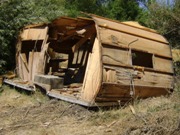(By Loren Krussow) – Most car guys like what other people call junk. We can’t walk by a broken transmission lying in the mud without a quick glance to see if we know what kind it is. A ’50s DeSoto that is deteriorated to where it will never again feel a twist of the key, yet somehow made it into the new century, is appreciated even by Ford and Chevy die-hards. It’s best to simply accept and enjoy this penchant for things long-ago discarded by others, but it can get out of hand. It can sweep over like a wave and take you in deeper, beyond fascination with mere drivetrain items and body hulks. It happens, and before you know it you’ve indeed gone too far. You become interested in old RVs.
There are ’40s-’80s campers, trailers, and motorhomes out there decomposing into dirt yards and hillsides. Some are small, many are huge, and few are pretty. They don’t just get rusty or dirty. It’s worse. People sometimes live in them under increasingly poorer circumstances as the vehicle ages. Stuck together on iron frames from wood and sheet metal with fasteners prone to loosening, and left out in the sun and rain, discarded trailers rot to bits like an abandoned shack that has more places for rodents to move into. One should turn up one’s nose at an old RV.
However if you likes junk—or let’s say vintage items with history—it may be the ultimate. What could be more?
While picking his way through a scrapyard, dump, or other field of society’s debris, a normal purveyor of fine mechanical discards often has in the back of his mind how objects he may encounter began their lives as useful items. He might picture the unknown-make transmission whirring along under the floor of some ‘50s family station wagon or how the DeSoto once brought the man who bought it to work in the morning. Let’s just say it takes a more serious individual to appreciate the abandoned and ruined travel trailer. In spite of whatever condition they may come to after a half-century of weather, most RVs were built new for a purpose beyond the utilitarian. Often they were a conspicuous luxury that people bought only when they could afford extra. In spite of boxy construction born of plywood sheet, they had style meant for showing off at neighbors and fellow campers with colored stripes and lettering trumpeting hoped-for prestige of the manufacturer name. There was carpet and upholstery and patterned curtains right there in a vehicle which you could eat and sleep and play dominoes in as you wandered the land.
If you, say, liked the ad for the Winnebago you saw in your 1971 National Geographic with the grand heights of Mt. Rushmore in the background, you were hopelessly hooked when you walked inside a real one at the annual recreation/vacation show or the display at the county fair.
That dream beginning may be recalled by the imagination when we walk through a long-retired camper, trailer, or motorhome and run our fingers down a faded window curtain. Here is the opening where the ice box was, these are knobs for the cook top which probably could still work. How many hot meals were prepared there for an eager, hungry family? We have to kick a few things out of the way to move up the narrow aisle, and because we’re not completely dis-attached from reality yet, we won’t touch the carpet.
It is not for the faint-of-heart to try to fix up an old trailer or motorhome. Usually there is plenty wrong with them, and most were not constructed well in the first place. However, if you happen to come across an example with a solid shell and only the interior is wreckage, you’ll never find a better opportunity to build novel things like vinyl-covered mini dining booths while requiring only the minimum in tools. A drill, screwdrivers, and circular saw will get you most of a wooden interior structure, after the initial wrecking-bar-and-Sawzall tearout. A good home sewing machine can do upholstery when pressed. Carpet and linoleum will trim with a box cutter, and glue we’ve worked with since childhood.
I’ve made a couple of attempts at RV projects. A memorable one was a post-WWII 1947 Spartan trailer (built by the aircraft company in riveted Alclad aluminum, aircraft-style) that I backed out of after the realization that I was in over my head time-wise. The latest is an ’80s motorhome that has seen better days but was well-built and acquired nearly free, not an unusual deal in this economy. The hope is that it can pull a trailer, and with familiar Chevy power, it will not be a strain on resources to fix any mechanical issues. If I were braver, I’d get an old polished-metal bus like some guys build into personalized coaches that attract admiring glances everywhere, but I’m not set up to fix bus motors and remember what happened with the Spartan.
If you are married and ever decide to try to do this, the wife needs to be on board with you at the beginning. If there was big trouble when she found a mere non-op ’60s sedan appear behind the garage, you may not survive long after you roll up all gleamy-eyed in a tattered stinky 30-foot motorhome. Minimum, it will be your new sleeping quarters. In my case, the vision is shared and my patient spouse participates with design and materials selection/purchase, and with continued effort and fresh paint we’ll someday have a genuinely OK-looking travel rig which can handle the family, tow a race car or Jeep, and be comfortable doing it. Even if the guys in the $150K, 40-foot diesel pushers look down their noses at us a bit. Around here, we’ve always been pretty content with freshened-up old stuff, even classic RVs.























